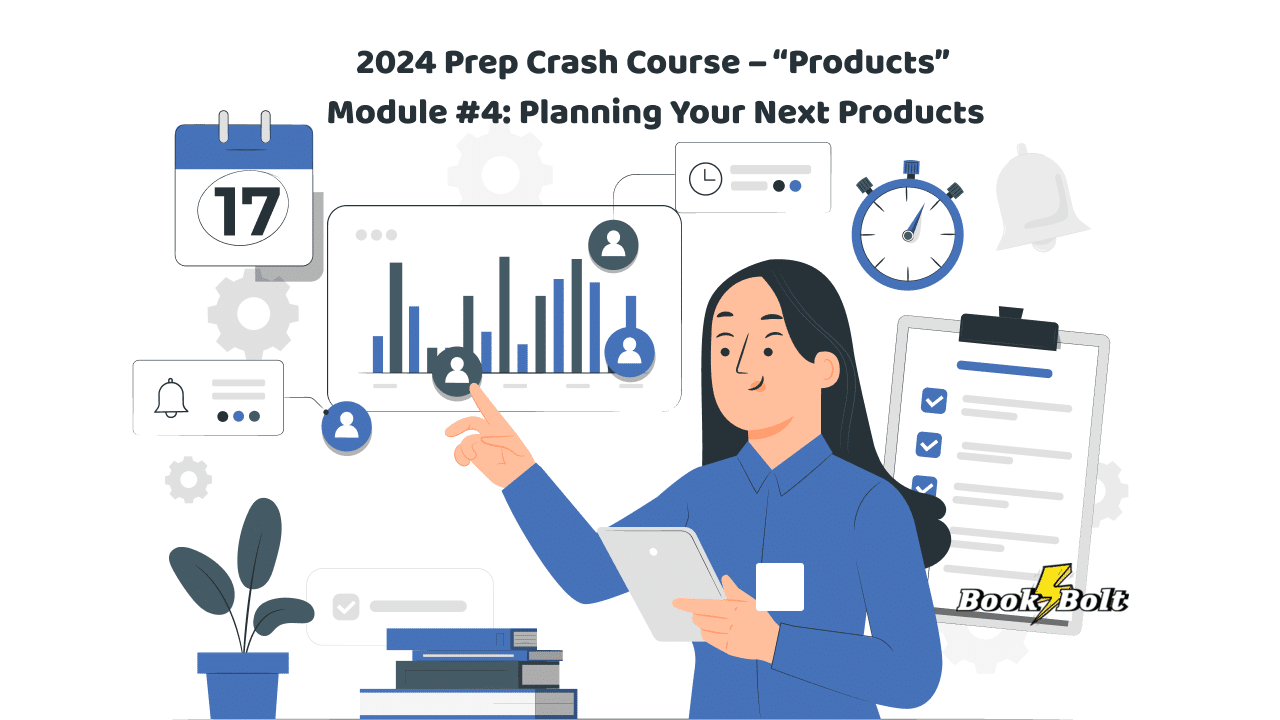
Kindle Direct Publishing has empowered creators to develop and sell a wide array of low-, no- and medium-content books. In this ever-evolving landscape, the ability to capitalize on missed opportunities and unexplored product ideas is a key strategy for planning new products for the upcoming year.
In the last two modules, we gathered data from 2023 for two key sources of information:
- Successful products
- Unsuccessful products
Now you know what kind of products to replicate and which ones to avoid. It’s time to start putting this data to work, planning your next line of products.
My recommendation is to start with your “backlog”.
These are the products that you planned to get to but couldn’t for one reason or another. Once you’ve determined – based on your experience in the last two modules – which of these undeveloped ideas merit the investment of time and money, you should also strip-mine off-your-radar opportunities.
These opportunities will inform your creativity as you flesh out the product plan that started with your backlog.
Here is a formula to help you determine which unproduced ideas should move forward and what new ideas can be built on them.
- Put all your unproduced concepts in a list and prioritize them based on the following criteria:
- Quick to create/low resource demand (just your time, no freelancers)
- How similar to prior year’s successful products
- Margin
- Proven Demand – this could be:
- A current hot trend
- a hot trend that has not yet plateaued
- an evergreen topic
- Marketing simplicity
Rate each product on a scale of 1-5 for each of the above criteria. The ones that rate better should move forward. The ones that rate worse should go wherever you file “Someday I’ll Get to That” projects (NEVER throw anything away!)
EXAMPLES:
A product that should move forward would look like this:
-
- Quick to create/low resource demand (just your time, no freelancers) 5
- How similar to prior year’s successful products 4
- Margin 3
- Proven Demand – this could be:
- A current hot trend
- a hot trend that has not yet plateaued
- an evergreen topic 5
- Marketing simplicity 5
In sum, this is the sweetspot: This concept can be produced, ultimately by you, quickly – the only cost is how you allocate your own time, it shares many of the product attributes of previously successful products, it has a good margin due to low creation/time costs, based on a well-known property with longevity and therefore should be able to sell itself.
A product that should be filed away (NOT thrown out) would look like this:
-
- Quick to create/low resource demand (just your time, no freelancers) 2
- How similar to prior year’s successful products 2
- Margin 1
- Proven Demand – this could be:
- A current hot trend 5
- a hot trend that has not yet plateaued
- an evergreen topic
- Marketing simplicity 5
This looks like a mixed bag, but it’s a definite “no” for a couple of reasons. The two high numbers can be manipulated if your emotional relationship to the concept is strong: “It’s a hot trend and it won’t cost me much and it should sell itself, so why not take a chance?” This blinds you to the other red flags that are important structural elements of a successful product.
This product will be slow to produce and have a high demand on resources, whether that’s time or money. “1” for “Margin” is subjective – for me it’s less than 5% on a POD product. “Slow” and “current hot trend” are natural enemies. This conflict alone should kill this product as you’re developing your new product line.
Let’s break each of these criteria down.
REFLECTING ON MISSED OPPORTUNITIES
What Did You Want to Sell but Didn’t Get to?
When planning for the coming year, the first step is to reflect on the products or ideas that you intended to launch but couldn’t. These could be anything from unique diaries to specialized workbooks.
Understanding the Obstacles: Why It Didn’t Happen
It’s equally important to understand why these opportunities were missed. Obstacles can range from resource constraints, such as time and financial investment, to market dynamics like oversaturation in a particular niche.
ANALYZING MARKET DEMAND
Market Research: Is There a Demand for Missed Products?
Identifying missed opportunities is only the first step. Market research is key to understanding whether there’s a genuine demand for these products. This research should encompass identifying existing competition and gaps in the market.
Consumer Preferences: Do Missed Products Align with Trends?
Consumer preferences and style trends are ever-evolving. To ensure the potential success of missed opportunities, it’s crucial to align them with current and emerging trends. Understanding what’s popular with the target audience is essential.
This is where BookBolt’s powerful tools can provide you the answers. You’ve already rinsed your concepts through prioritization criteria. Now you need to check your unused/new concepts through BookBolt’s keyword and competition tracking tools to evaluate the concept’s chances of success.
EVALUATING RESOURCE REQUIREMENTS
Resource Assessment: Do You Have What It Takes?
Before moving forward, a comprehensive assessment of the required resources is necessary. Evaluate whether you truly have the time, talent, and financial resources to bring the missed opportunities to life.
Budget and Cost Considerations: Can It Be Done Profitably?
The potential costs involved in producing and marketing the missed products should be meticulously calculated. It’s essential to determine whether launching these books can be done profitably and whether the expected returns justify the investment.
IDENTIFYING NEW OPPORTUNITIES
Innovative Twist: Can You Put a Fresh Spin on Missed Ideas?
Rather than pursuing missed opportunities exactly as originally conceived, explore innovative ways to put a fresh spin on these ideas. Sometimes, a slight adaptation can make an idea more appealing to the target audience.
Niche Exploration: Unearthing Untapped Niches
In the vast world of KDP, there are often untapped niches waiting to be discovered. Identifying these niches and understanding the specific needs of niche markets can open new avenues for missed opportunities.
REVISING YOUR PRODUCT LINEUP
Product Lineup Strategy: Balancing Old and New
With missed opportunities reevaluated and new ideas explored, the next step is to develop a revised product lineup for the upcoming year. This lineup should strike a balance between classic products that have proven their appeal over time and innovative designs inspired by the missed opportunities.
Marketing and Promotion: Aligning with Missed Opportunities
Planning marketing and promotional strategies is crucial. These strategies should emphasize the innovative and fresh aspects of the new products arising from missed opportunities. Content and campaigns should highlight how these products cater to the needs and desires of the target audience.
In the dynamic world of self-publishing, a reflective and forward-looking approach is essential for planning new KDP products. By revisiting missed opportunities and using them as a source of inspiration, you can uncover fresh avenues for success.
The key takeaway: every missed opportunity can be transformed into a future triumph. Whether it’s launching specialized workbooks, unique diaries, or any other unexplored product, you have the opportunity to adapt, refine, and create content that resonates with your target audience.
In the words of renowned inventor Alexander Graham Bell, “When one door closes, another opens.” By applying these strategies, KDP publishers can harness the potential of missed opportunities, turning them into open doors leading to a successful future in self-publishing.


